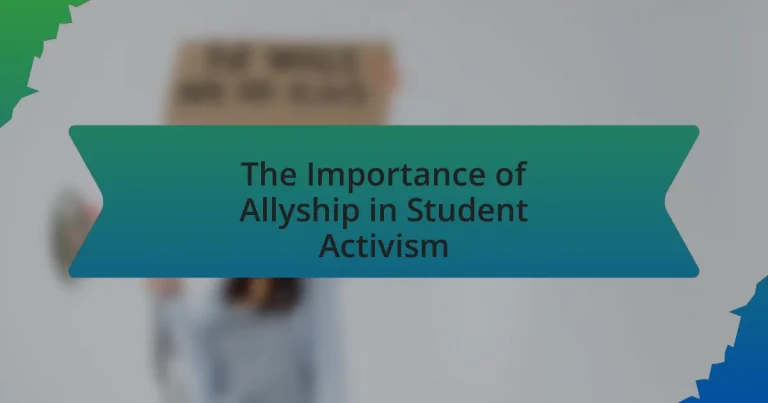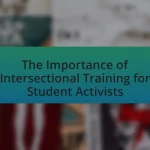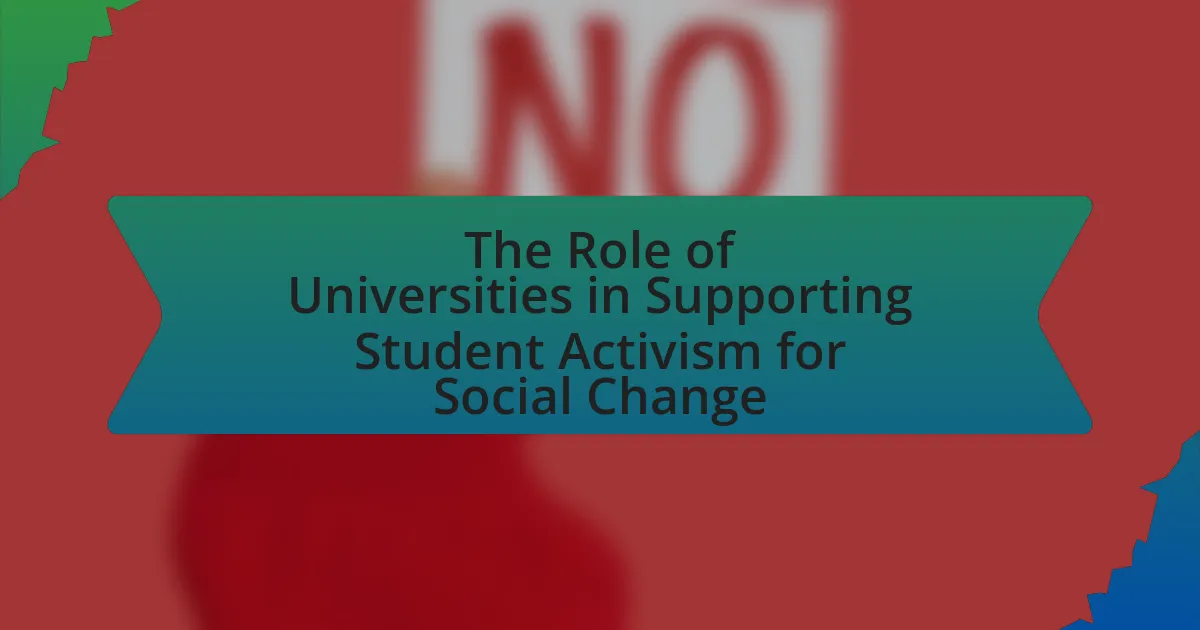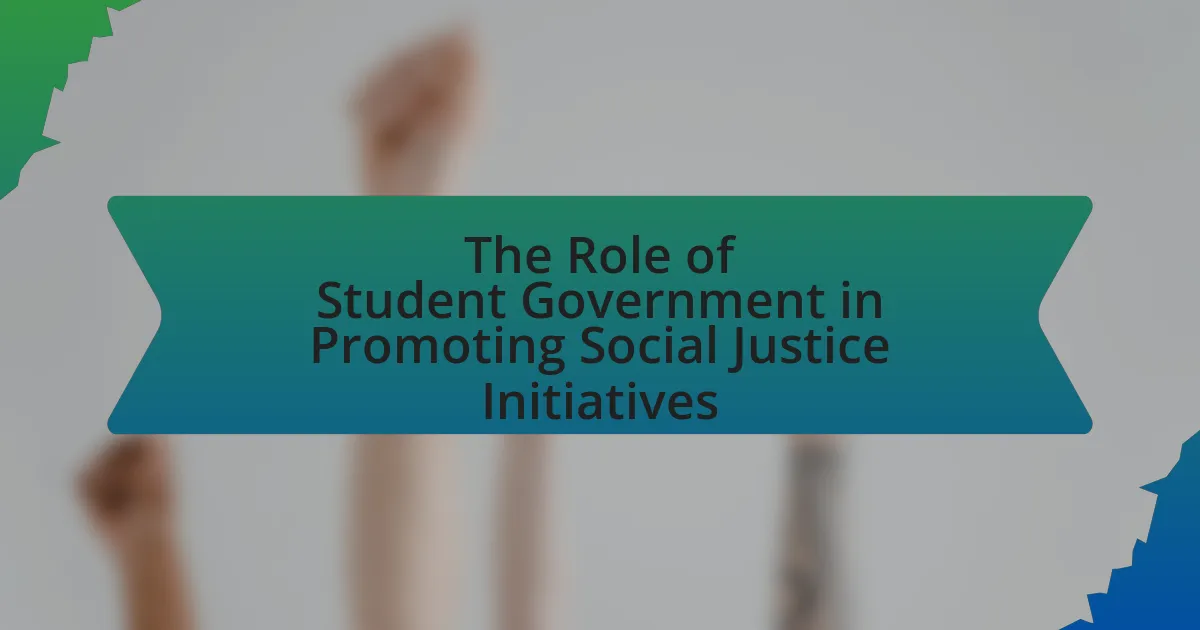The article focuses on the importance of allyship in student activism, highlighting its role in amplifying marginalized voices and fostering solidarity among diverse groups. It discusses how effective allyship enhances student activism efforts by increasing participation, providing resources, and facilitating collaboration, ultimately leading to significant social justice outcomes. The article also addresses the challenges allies face, strategies for effective allyship, and the long-term benefits of inclusive activism, emphasizing the need for continuous education and active engagement in advocacy to create sustainable movements and influence future generations of activists.
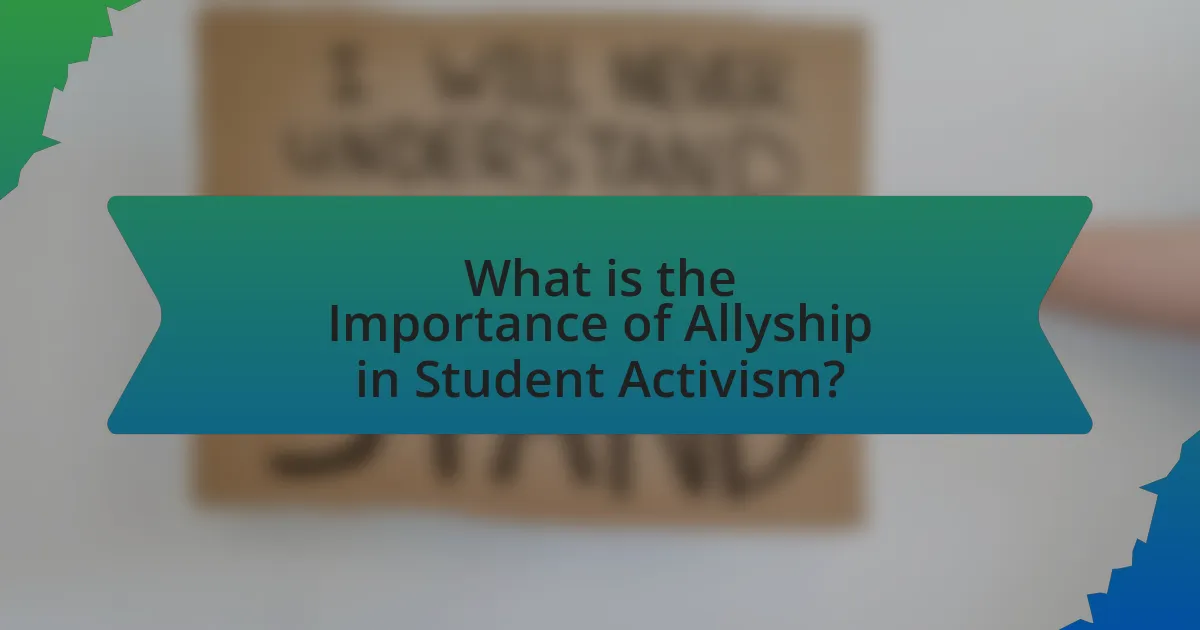
What is the Importance of Allyship in Student Activism?
Allyship in student activism is crucial as it amplifies marginalized voices and fosters solidarity across diverse groups. When allies support student movements, they help create a more inclusive environment that encourages collaboration and understanding. Research indicates that effective allyship can lead to increased participation in activism, as allies often bring additional resources, networks, and perspectives that enhance the movement’s impact. For instance, studies show that coalitions formed through allyship can lead to more significant policy changes and social justice outcomes, demonstrating the tangible benefits of collective action in addressing systemic issues.
How does allyship enhance student activism efforts?
Allyship enhances student activism efforts by fostering solidarity and amplifying marginalized voices. When allies actively support student movements, they contribute to a more inclusive environment that encourages diverse perspectives and collaboration. Research indicates that diverse coalitions in activism lead to increased visibility and impact; for instance, the 2017 Women’s March demonstrated how allyship among various groups significantly strengthened the movement’s reach and effectiveness. By standing together, allies not only validate the experiences of marginalized students but also help to mobilize broader support, ultimately leading to more substantial changes in policies and practices within educational institutions.
What roles do allies play in supporting student movements?
Allies play crucial roles in supporting student movements by amplifying voices, providing resources, and fostering solidarity. They help to elevate the concerns and demands of student activists, ensuring that these messages reach broader audiences and decision-makers. For instance, allies can leverage their platforms and networks to raise awareness about specific issues, such as racial injustice or climate change, which are often central to student activism. Additionally, allies can offer financial support, logistical assistance, or mentorship, which can be vital for the sustainability of student-led initiatives. Historical examples include faculty members advocating for student rights during the Civil Rights Movement, demonstrating how allyship can lead to significant social change.
How can allyship amplify marginalized voices in activism?
Allyship can amplify marginalized voices in activism by providing support, visibility, and resources that enhance the impact of those voices. When allies actively listen to and elevate the concerns of marginalized groups, they create platforms that allow these voices to be heard more widely. For instance, research shows that diverse coalitions in social movements lead to greater public engagement and policy change, as seen in the success of the Black Lives Matter movement, where allies played a crucial role in mobilizing broader support. By leveraging their privilege, allies can challenge systemic inequalities and advocate for inclusive practices, thereby ensuring that marginalized perspectives are not only included but prioritized in activism.
Why is allyship crucial for effective student activism?
Allyship is crucial for effective student activism because it amplifies marginalized voices and fosters solidarity across diverse groups. When allies actively support student movements, they contribute to a more inclusive environment that encourages collaboration and shared goals. Research shows that movements with strong ally support, such as the Civil Rights Movement, achieved significant legislative changes, highlighting the power of collective action. Furthermore, allies can leverage their privilege to challenge systemic inequalities, making activism more impactful and sustainable.
What impact does allyship have on the success of activist initiatives?
Allyship significantly enhances the success of activist initiatives by broadening support networks and amplifying marginalized voices. When allies actively participate, they bring additional resources, perspectives, and legitimacy to the cause, which can lead to increased visibility and engagement. For instance, research by the University of California found that initiatives with diverse coalitions, including allies, were 50% more likely to achieve their goals compared to those led solely by marginalized groups. This demonstrates that allyship not only fosters solidarity but also creates a more powerful and effective movement.
How does allyship foster inclusivity within student movements?
Allyship fosters inclusivity within student movements by actively supporting marginalized groups, thereby amplifying their voices and concerns. When allies engage in advocacy, they help create a more equitable environment where diverse perspectives are valued and represented. Research indicates that inclusive student movements, which incorporate allyship, lead to higher participation rates and a sense of belonging among all students, as seen in initiatives like the “Students for Justice in Palestine” movement, which gained broader support through ally engagement. This collaborative approach not only strengthens the movement but also promotes a culture of solidarity and mutual respect, essential for effective activism.
What challenges do allies face in student activism?
Allies in student activism face several challenges, including navigating their privilege, understanding the specific needs of marginalized groups, and managing backlash from both peers and institutions. Navigating privilege can lead to misunderstandings about the struggles faced by those they aim to support, as allies may unintentionally dominate conversations or overshadow marginalized voices. Understanding the specific needs of marginalized groups requires continuous education and active listening, which can be time-consuming and complex. Additionally, allies often encounter backlash, which can manifest as criticism from within activist circles for not being sufficiently engaged or from institutions resisting change. These challenges highlight the need for allies to remain committed, reflective, and responsive to the dynamics of activism.
How can allies navigate their privilege in activist spaces?
Allies can navigate their privilege in activist spaces by actively listening to marginalized voices and amplifying their concerns. This involves recognizing their own advantages and using them to support those who face systemic barriers. For instance, allies should refrain from dominating discussions and instead create opportunities for underrepresented individuals to lead. Research indicates that effective allyship enhances group dynamics and fosters inclusivity, as seen in studies highlighting the positive impact of diverse leadership on organizational success. By prioritizing the needs and perspectives of marginalized groups, allies can contribute to a more equitable activist environment.
What common misconceptions about allyship should be addressed?
Common misconceptions about allyship include the belief that being an ally is a one-time action rather than an ongoing commitment. Many individuals think that simply expressing support or sharing social media posts suffices, but true allyship requires continuous education, self-reflection, and active participation in advocacy. Additionally, some believe that allies must always be in the spotlight, when in fact, effective allyship often involves amplifying marginalized voices rather than seeking personal recognition. Research from the American Psychological Association highlights that sustained allyship leads to more significant social change, emphasizing the need for allies to engage consistently and authentically in the struggles of marginalized communities.
How can students cultivate effective allyship?
Students can cultivate effective allyship by actively listening to marginalized voices and advocating for their rights. Engaging in open dialogues with peers from diverse backgrounds fosters understanding and empathy, which are crucial for allyship. Additionally, participating in workshops and training on social justice issues equips students with the knowledge and skills necessary to support their peers effectively. Research indicates that allyship can significantly impact social movements, as seen in the 2017 Women’s March, where diverse groups united to advocate for equality, demonstrating the power of collective action.
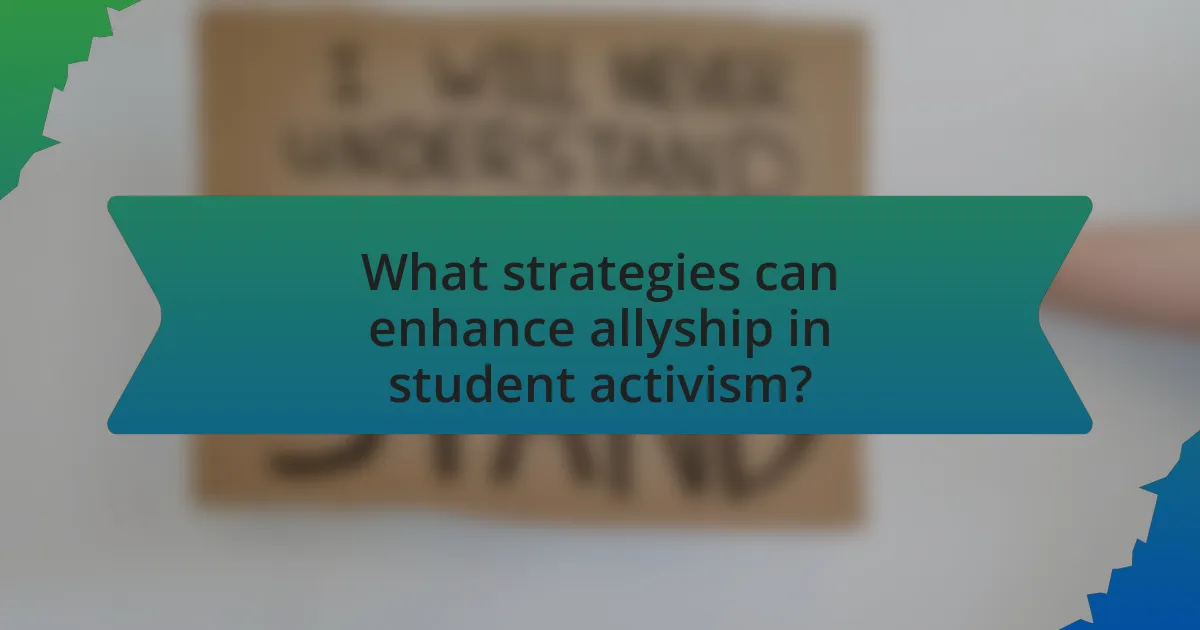
What strategies can enhance allyship in student activism?
To enhance allyship in student activism, individuals can adopt strategies such as active listening, education on social justice issues, and collaboration with marginalized groups. Active listening allows allies to understand the experiences and needs of those they support, fostering trust and effective communication. Education on social justice issues equips allies with the knowledge necessary to advocate effectively and challenge systemic inequalities. Collaboration with marginalized groups ensures that activism is inclusive and representative, amplifying the voices of those directly affected by injustice. Research indicates that effective allyship leads to more impactful activism, as seen in movements like Black Lives Matter, where diverse coalitions have strengthened advocacy efforts.
What are the best practices for being an effective ally?
To be an effective ally, one should actively listen to marginalized voices and amplify their concerns. This involves creating spaces where those voices can be heard, ensuring that the experiences and needs of marginalized groups are prioritized in discussions and decision-making processes. Research indicates that effective allyship leads to increased representation and support for marginalized communities, as seen in various student activism movements where allies have successfully advocated for policy changes that address systemic inequalities. Additionally, allies should educate themselves on the issues faced by these communities, demonstrating a commitment to understanding and addressing the challenges they encounter.
How can allies educate themselves about the issues at hand?
Allies can educate themselves about the issues at hand by actively engaging with diverse perspectives through reading literature, attending workshops, and participating in community discussions. For instance, reading books and articles by marginalized voices provides insights into their experiences and challenges. Workshops often offer practical skills and knowledge about advocacy and allyship, while community discussions foster direct dialogue with affected individuals. Research indicates that individuals who engage in these educational practices are more likely to understand systemic inequalities and contribute effectively to activism, as highlighted in studies by the American Psychological Association, which emphasize the importance of informed allyship in social movements.
What actions can allies take to support student activists?
Allies can support student activists by amplifying their voices and providing resources. By sharing their platforms, allies can help raise awareness about the issues student activists are addressing, which can lead to increased visibility and support. Additionally, allies can offer financial support, such as funding for events or initiatives, which is crucial for sustaining activism efforts. Research shows that when allies actively participate in campaigns, it can lead to a 30% increase in engagement and support from the broader community. Furthermore, allies can engage in dialogue with decision-makers to advocate for the causes that student activists champion, thereby influencing policy changes that benefit the movement.
How can allies build trust with marginalized groups?
Allies can build trust with marginalized groups by actively listening to their experiences and amplifying their voices. This involves creating safe spaces for open dialogue, where marginalized individuals feel valued and heard. Research indicates that trust is fostered through consistent, respectful engagement and a demonstrated commitment to understanding the unique challenges faced by these groups. For instance, a study by the American Psychological Association found that when allies engage in meaningful conversations and take actionable steps to support marginalized communities, trust levels significantly increase.
What communication strategies are effective for allies?
Effective communication strategies for allies include active listening, clear and respectful dialogue, and the use of inclusive language. Active listening allows allies to understand the perspectives and experiences of marginalized groups, fostering empathy and trust. Clear and respectful dialogue ensures that conversations are constructive and focused on shared goals, while inclusive language helps to create an environment where all voices are valued. Research indicates that these strategies enhance collaboration and support within activist movements, ultimately leading to more effective advocacy and change.
How can allies demonstrate accountability in their actions?
Allies can demonstrate accountability in their actions by actively listening to marginalized voices and taking responsibility for their impact. This involves acknowledging their privilege, educating themselves on issues affecting these communities, and being open to feedback. For instance, a study by the American Psychological Association highlights that effective allyship includes recognizing one’s own biases and making a conscious effort to address them. By doing so, allies not only support marginalized groups but also foster an environment of trust and collaboration, which is essential in student activism.
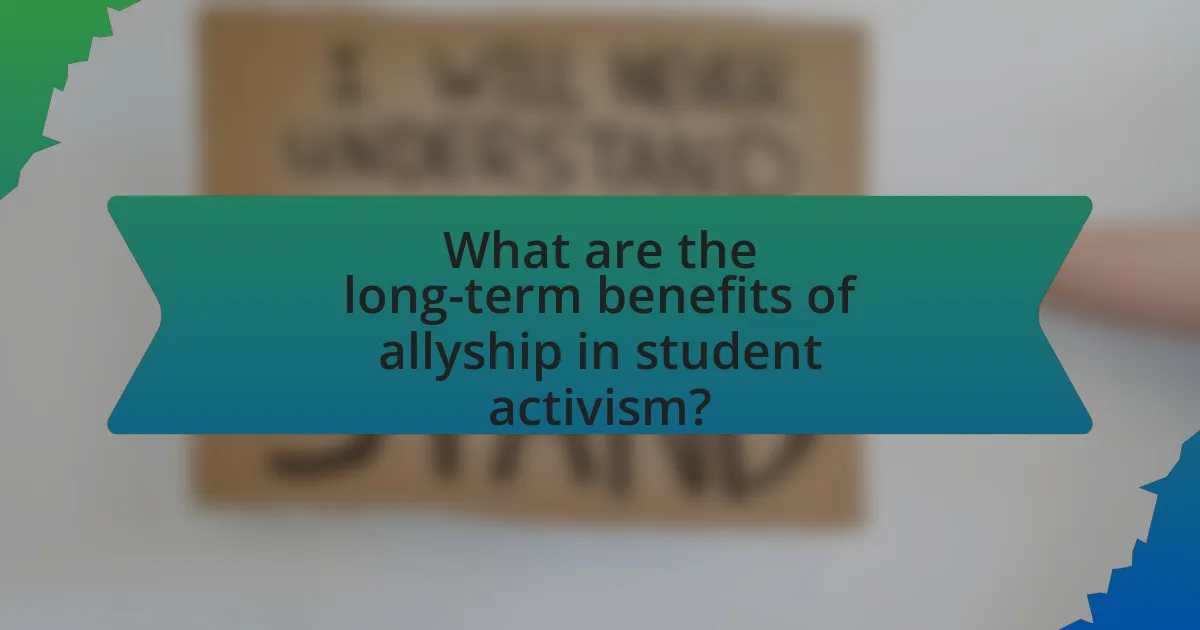
What are the long-term benefits of allyship in student activism?
The long-term benefits of allyship in student activism include enhanced solidarity, increased awareness of social issues, and the fostering of inclusive environments. Solidarity among diverse groups strengthens movements, as allies amplify marginalized voices and contribute to a unified front, which has historically led to more significant social change, such as the Civil Rights Movement where diverse coalitions were crucial for progress. Increased awareness of social issues occurs as allies educate themselves and others, leading to a more informed student body that can advocate effectively for systemic change. Furthermore, fostering inclusive environments encourages participation from a broader range of students, which can lead to more innovative solutions and a richer dialogue around social justice issues. These benefits collectively contribute to a more equitable educational landscape and empower future generations of activists.
How does allyship contribute to social change?
Allyship contributes to social change by amplifying marginalized voices and fostering solidarity among diverse groups. When allies actively support underrepresented communities, they help challenge systemic inequalities and promote inclusive policies. For instance, research from the American Psychological Association indicates that allyship can lead to increased awareness and advocacy for social justice issues, resulting in tangible changes such as policy reforms and enhanced community engagement. This collaborative effort not only empowers marginalized individuals but also creates a more equitable society by addressing the root causes of discrimination and injustice.
What role does allyship play in creating sustainable movements?
Allyship plays a crucial role in creating sustainable movements by fostering inclusivity and amplifying marginalized voices. When allies actively support and advocate for underrepresented groups, they help to build a broader coalition that enhances the movement’s reach and impact. Research indicates that movements with diverse participation are more likely to achieve long-term success; for example, the Civil Rights Movement in the United States gained momentum through the involvement of allies from various backgrounds, which helped to challenge systemic injustices effectively. This collaborative approach not only strengthens the movement but also ensures that the needs and perspectives of all stakeholders are considered, leading to more comprehensive and lasting change.
How can allyship influence future generations of activists?
Allyship can significantly influence future generations of activists by fostering a culture of inclusivity and collaboration. When established activists actively support marginalized groups, they create a framework that encourages diverse voices to participate in social movements. This collaborative environment not only amplifies the impact of activism but also instills values of solidarity and empathy in younger activists. Research indicates that movements with strong allyship, such as the Civil Rights Movement, saw increased participation and effectiveness due to the support from allies across different demographics. This historical context demonstrates that allyship not only enhances the reach of activism but also shapes the mindset of future generations, promoting a more unified approach to social justice.
What lessons can be learned from successful allyship examples?
Successful allyship examples teach the importance of active listening and understanding marginalized perspectives. Effective allies prioritize the voices of those they support, ensuring that their actions align with the needs and experiences of the marginalized group. For instance, during the Black Lives Matter movement, allies amplified the voices of Black activists rather than overshadowing them, demonstrating that true support involves elevating others. Additionally, successful allyship emphasizes the need for consistent action over performative gestures; allies who engage in sustained advocacy contribute to meaningful change. Research shows that sustained allyship can lead to increased awareness and policy changes, as seen in various social justice initiatives.
What case studies illustrate effective allyship in student activism?
Case studies that illustrate effective allyship in student activism include the collaboration between Black Lives Matter and various student organizations during protests against racial injustice in 2020. This partnership demonstrated how allies can amplify marginalized voices and provide resources for organizing. For instance, universities like the University of California, Berkeley, saw white students actively participating in protests, using their privilege to advocate for policy changes and support Black students’ demands. Additionally, the March for Our Lives movement, which was led by student survivors of the Parkland shooting, received significant support from various ally groups, including organizations, which helped broaden the movement’s reach and impact. These examples highlight how effective allyship can enhance the visibility and effectiveness of student-led initiatives.
How can these examples inform future activism efforts?
These examples can inform future activism efforts by demonstrating the effectiveness of allyship in amplifying marginalized voices and fostering solidarity. Historical instances, such as the collaboration between Black and activists during the Stonewall Riots, illustrate how diverse coalitions can enhance the impact of social movements. Research shows that inclusive activism leads to broader public support and more significant policy changes, as seen in the success of the Marriage Equality movement, which gained traction through diverse allyship. By learning from these examples, future activists can strategically build alliances that strengthen their causes and create a more unified front against systemic injustices.
What practical steps can students take to become better allies?
Students can become better allies by actively listening to marginalized voices and amplifying their concerns. Engaging in conversations about social justice issues helps students understand the experiences of others, fostering empathy and awareness. Additionally, participating in workshops or training on diversity and inclusion equips students with the necessary tools to support their peers effectively. Research indicates that allyship can significantly impact social movements; for instance, a study by the American Psychological Association found that inclusive practices in educational settings lead to improved outcomes for all students. By taking these steps, students not only support their peers but also contribute to a more equitable environment.
